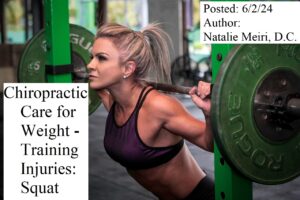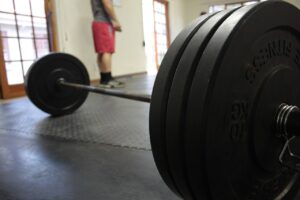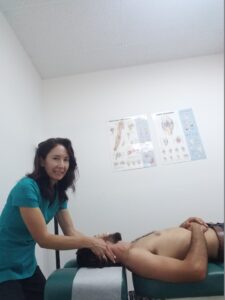
From Dr. Natalie Meiri’s Clinical Pearl Stories:
Chiropractic Care for Weight-Training Injuries: Squat
This was a 31 year old patient with a chief complaint of bilateral (both) shoulder, neck and back pain incurred at the gym. To be HIPPA compliant, I will call him Jacob instead of his real name.
Jacob was an athlete. He worked out at the gym almost every day. Jacob said a month ago he had injured his neck, back and shoulders lifting weights at the gym. Specifically, he was lifting 475 pounds in a squat. He had no past history of trauma otherwise. Getting massages seem to provide some relief, but his pain level was still described as 9/10 in his intake. Additionally, Jacob reported pain while doing any over head exercises at the gym (pull-ups, squats etc.)
The Squat Exercise
The squat exercise is performed with the barbell held horizontally across the back of the shoulders. Then the lifter removes the barbell from the power lifting rack and steps backwards. During training, the lifter then lowers the body by flexing at the hip, knee and ankle joints. This is done until the hip crease is lower than the top of the knee.
Overall, the exercise is good for strengthening and health. Factors that can lead to injury may be due to improper lifting technique. Also, the load maybe excessive. And especially, the combination of high loads and improper technique may lead to injury. Lastly, fatigue has been implicated as a factor to sporting injury. Furthermore, if you are fatigued, it may impact lifting technique. Therefore, a strategy to reduce the risk of injury in power lifting athletes is important. Warm-up is essential as it is for any exercise. And it may be smart to perform the most demanding exercises immediately after the warm-up. Squats could be performed during the initial part of the training session.
Injuries associated with the squat exercise are numerous. For example, they include: neck/back (e.g. disc/joint), shoulder and quadriceps tendon injuries, and injuries to the knee ligaments and tendons.

Jacob’s Examination at Meiri Chiropractic
Upon examination, I gave Jacob a diagnosis for a sprain in his back and bilateral glenohumeral joints (shoulder joints). He definitely had positive tests for his neck, back and bilateral glenohumeral joints (shoulder joints). I would order imaging (e.g. x-rays, MRI) in a month if there was no improvement.
Jacob’s Treatment and Outcome at Meiri Chiropractic
Firstly, Jacob’s treatments included chiropractic adjustments/ manipulation to his neck, back, both glenohumeral joints and associated regions. Secondly, associated regions included his hips. Thirdly, soft tissue therapy (myofascial release, pressure point and various post isometric relaxation procedures) and modalities (cold/heat therapy and electric muscle stimulation) were administered. Fourthly, he was given therapeutic exercises to continue his treatment at home.
Jacob felt much better from the first treatment. He was to avoid any overhead activity initially.
It took 12 visits before he was able to resume over head activities/exercises at the gym. Thereafter, he continued his chiropractic care for full recovery from his injuries. And yes, he resumed his squat exercises! Finally, he returned for periodic adjustments for overall wellness

Chiropractic Care for Weight -Training Injuries: Squat
At Meiri Chiropractic we spend the time necessary to examine, diagnose and treat every neuromusculoskeletal condition and various ailments you have. Chiropractic is a holistic and natural way to not only treat existing conditions, but to keep your body in its best working condition. We have been offering the best effective chiropractic care in Palm Beach county since 2006. Many of our patient reviews note our excellence. Call us today at 561-253-8984 to make an appointment or to find out more about Chiropractic Care for Weight -Training Injuries: Squat.
Reference: https://www.ncbi.nlm.nih.gov/pmc/articles/PMC6059276/